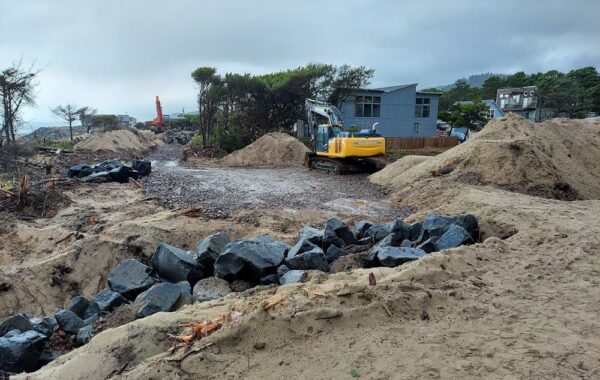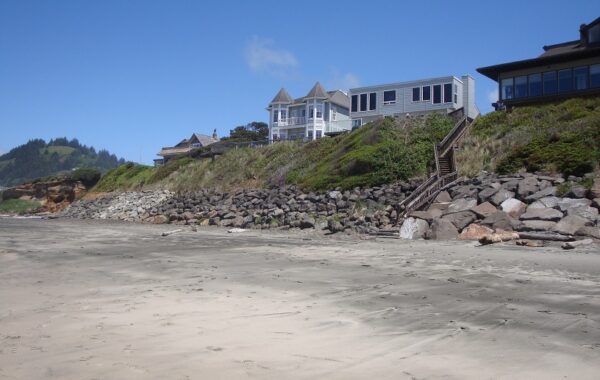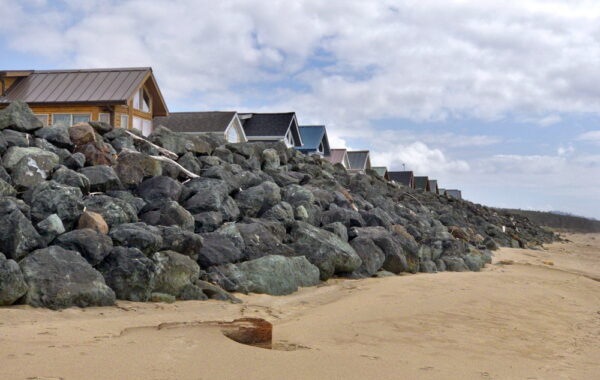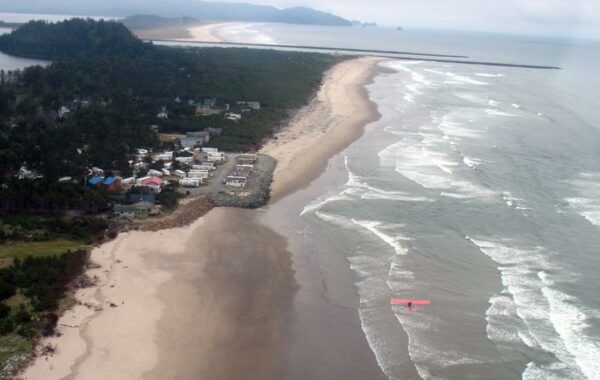Shoreline and Land Management
Protecting the integrity of our public beaches and maintaining flexibility for dynamic natural processes to shape our coastline

What is Shoreline Armoring?
Shoreline armoring describes human-constructed protective measures to prevent erosion and protect coastal properties from the effects of natural processes, like wave action and tidal forces. These measures are typically implemented in areas where the coastline is eroding and where there is a need to stabilize the shoreline.
Riprap refers to a type of shoreline protection or erosion control technique that involves placing a layer of large, durable rocks or stones along the coastline or riverbanks. These rocks are typically angular and interlock with each other, creating a barrier that absorbs and dissipates the energy of waves and currents.
In addition to riprap, shoreline armoring may include the construction of seawalls, bulkheads, groins, jetties, and revetments. These structures are built to shield the coast from the forces of erosion and wave action. While they may effectively protect property and infrastructure, they can have negative environmental impacts.
Effects of Hardening the Shoreline
Shoreline armoring, such as riprap revetments or seawalls, is a growing concern on the Oregon coast. Armoring protects private property at the expense of our public shoreline. Beaches are dynamic ecosystems, shaped by waves, tides, and winds. Artificially armoring our shoreline disrupts the natural movement of dunes and sediment, with consequences for our beach landscapes and the species that rely on them.
Hardened structures, aside from being unsightly, can deflect waves onto adjacent properties, increasing erosion at those locations and creating a “domino effect” of spreading riprap. Armoring can also deprive beaches of their sand supply from bluffs and dunes and lead to the scouring of sand by waves in front of the structures, further advancing the cycle of erosion. As beaches narrow, riprap structures can become artificial peninsulas that block travel along the beaches at higher tides. The cumulative impact of widespread shoreline armoring could lead to the diminishment and eventual loss of Oregon’s iconic public beaches.

Rules and Regulations
Oregon’s shoreline armoring regulations are primarily based on Statewide Planning Goal 18, related to beaches and dunes. Properties developed before January 1, 1977, are eligible for armoring, while later development generally isn’t, but two significant loopholes exist. The Oregon Parks and Recreation Department (OPRD) considers properties with adjacent public services (roads, sewers, utility lines) as developed. Additionally, emergency permits are granted when structures are threatened by erosion, even if not eligible.

Longterm Consequences
OPRD prioritizes alternatives to riprap, such as temporary soft structures, vegetation, or moving structures back from the shoreline, but this is rarely enforced. Furthermore, the public recreation zone extends to the “statutory vegetation line” (SVL), which can shift if erosion occurs. However, with riprap in place, the vegetation line is blocked from moving further upslope, meaning that the public beach is pinched off. Loopholes allow cities or counties to permit armoring on ineligible properties in dune areas near the SVL, potentially harming the public beach.
The Pine Beach case exemplifies this issue, as initial approvals allowed property owners to install hardened structures during ongoing appeals. Oregon Shores aims to change the law to prevent such infractions in the future.
While Goal 18 intended to protect beaches and dunes from armoring, private structures intruding on the public beach essentially take a public resource. Despite restrictions on newly developed properties, riprap continues to encroach, necessitating a statewide discussion to prevent cumulative shoreline armoring effects and allow our beaches to adapt to sea level rise and climate change.

What We're Doing
Oregon Shores tracks every application for shoreline alteration on the entire Oregon coastline. Many applications have serious flaws, such as the absence of a geologist’s report or a failure to consider alternatives, and we oppose those on specific grounds. But we also oppose all such applications, even those that are allowable under the current regulations, as a protest that piecemeal decisions regarding individual properties ignore cumulative effects. We argue that it is time for a statewide conversation about the future of our beaches as erosion increases with sea level rise and more intense storm surges, due to climate change. If we don’t think more holistically about shoreline management, we could lose our beaches.

